Agile product development is a philosophy that’s applied to PM software and product development. The technical product owner is the most important individual in the scrum framework. They are primarily responsible for maximizing product value by defining product goals, and product roadmap, and managing backlog.
A product owner is an expert who is experienced in the product development. That said, there are times when things get too technical. In such cases, the product owner needs technical assistance to create, organize, and communicate backlog items.
This technical need introduces a new role called technical product owner.
What is a Technical Product Owner?
A technical product owner manages the business and technical aspects of the product development. Not all product owners need to have technical skills. After all, a product owner is responsible for backlog management and maximizing product value.
Neither of these two implies the need to have deep knowledge of technical skills. For that reason, some product owners need the technical expertise and technical resources to deal with the technicalities of the development process.
For that reason, technical product owners are the ones who manage the technical side of things during product development. From this perspective, a technical product owner owns a component or a feature of a product and not the entire product.
A component/feature owner owns one or more components or features of the product and is responsible for maximizing its value:
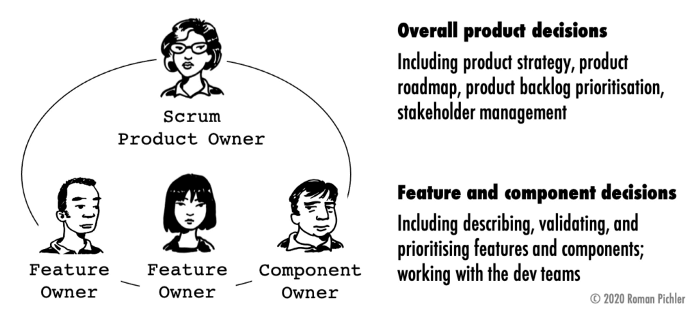
Since feature and component owners work closely with development teams, they tend to have stronger technical skills than product owners do.
One or more technical product owners can work with the product owner and the development team. They act as the bridge between the development team and the product owner.
Robert Galen explains how they felt the need to create a new role while working on a client project. It was a large-scale infrastructural project with technical requirements and the product owner had no experience in managing such a project within the scrum.
Therefore, a technical product owner role was created and a development manager was assigned the role. His main role was to assist the product owner (known as the functional product owner) and both worked together.
If you’re interested in becoming a great product owner, then check out our Product Owner Certification course.
What Does a Technical Product Owner Do?
Unlike a scrum product owner who wears numerous hats, a technical product owner doesn’t wear multiple hats. Their role is clearly defined and is purely technical. If there isn’t much technical work to do, a technical product owner might not be needed at all.
Here is a list of the tasks that a technical product owner performs:
1. Technical Resource
A technical product owner acts as the technical resource for the agile product owner and the scrum team members. A product owner might not always be technically knowledgeable in all the development aspects.
For example, it’s common for product owners to struggle when they have to review infrastructure improvement-related stories or technical user stories.
In such a situation, a product owner needs a technical resource who will do three things:
- Understand customer needs
- Decode the technical requirements and add them to the backlog via the product owner
- Ensure stories are incorporated as expected
The technical product owner, according to Steve Vaughn, carries technical knowledge into strategic conversations about the product.
All products need long-term planning and mapping therefore a technical product owner requires a complete understanding of the business’s technical aspects, and capabilities. Having someone on board to make correct technical decisions proves to be very helpful.
In the absence of a technical product owner, someone from the development team must be involved in the decision, planning, and product mapping (as a technical resource) that will negatively impact the daily scrum and short-term deliverables of the development team.
If you engage a development resource (an experienced and the main individual) in planning, it will negatively impact the current sprint.
A technical product owner saves the day as they act as an individual who isn’t involved in a Scrum sprint. Instead, they work with the product owner and assist in technical planning.
2. Technical Advisor
A technical product owner acts as a technical advisor to the product owner and stakeholders. They include the client, product manager, C suite, scrum master, development team, and internal departments (e.g. marketing, sales, customer support, and others).
In doing so, a technical product owner serves side-by-side with the product owner. they tend to be more active in technical discussions than regular product owners.
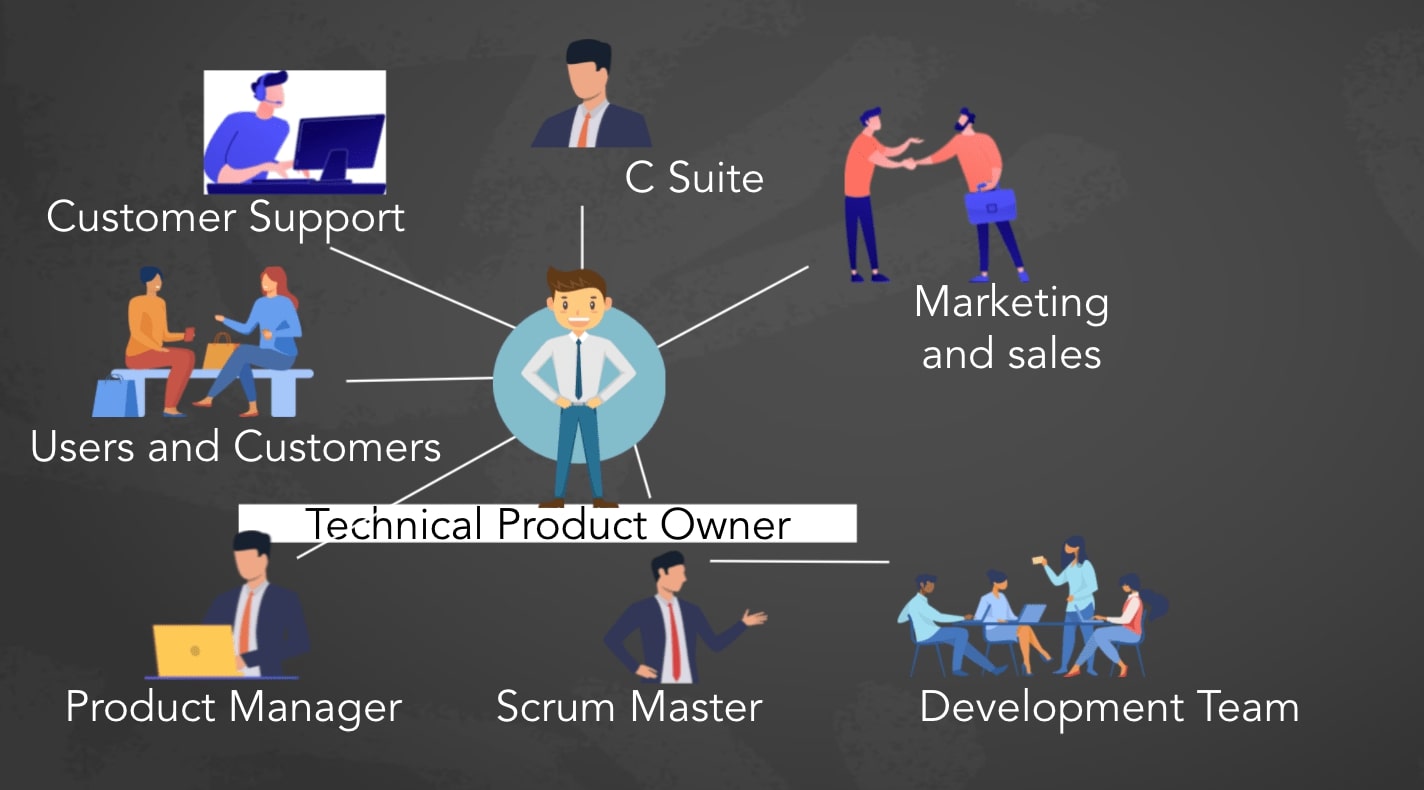
Some of the key tasks a technical product owner performs as a technical advisor include:
- Assisting and advising the product owner on key technical decisions
- Sprint planning and resolving all technical confusion
- Making sprint more efficient by identifying what goes in and what doesn’t
- Helping the product owner define, manage, and accept technical stories
- Assisting in stories related to technical debt
The technical product owner isn’t always directly involved in planning. Instead, their role is to assist the product owner as maximizing product value is the responsibility of the product owner and not that of a technical advisor.
However, complex technical products (e.g. architectural stories or large-scale technical products) require more engagement from the technical product owner. For that reason, they might have to assist and help understand the technical ins and outs of all the stakeholders.
3. Customer-Technology Bridge
Not all clients are technically knowledgeable. Most of them aren’t. They simply want things done.
There has to be someone (other than the product owner who is more of a customer advocate) who will interact with the customer, understand their needs, explain technical acronyms to customers, give realistic estimates, and make them understand what’s doable and what isn’t while maintaining technical transparency.
The below-mentioned three empirical scrum pillars need maintenance technically by the technical product owner:
- Transparency
- Inspection
- Adaptation
Both inspection and adaptation require analytical skills and in-depth technical knowledge.
A technical product owner, therefore, acts as the customer-development team bridge. This involves regular inspection of the sprint, taking corrective actions to avoid deviations, and communicating the same to the customer in an understandable way.
A technical product owner acts as a bridge that connects the customer and the agile team. They work both ways.
4. Product Owner and Scrum Team Connection
Just like a smooth and transparent connection between a customer and a scrum team is necessary for agile development, a sound connection between the product owner and team members is equally important.
The product owner is responsible for product backlog management which includes:
- Defining and communicating product goal
- Ordering, creating, and communicating product backlog items
- Making backlog transparent, understood, and visible
According to Scrum Guides:
“The product owner may do the above work or may delegate the responsibility to others. Regardless, the product owner remains accountable.”
Any or all technical items in the product backlog are ordered, created, and communicated by the technical product owner to keep it transparent, visible, and understood.
The agile team will fail to deliver on time if the product owner fails to create and communicate backlog items due to a lack of technical knowledge.
To maintain a transparent and visible connection between the product owner and the agile development team, everything must be crystal clear.
For highly technical products or in cases where the product owner isn’t familiar with technical acronyms, a technical product owner becomes necessary.
5. System Maintenance and Backend Infrastructure Management
This is a technical task that requires in-depth technical knowledge, and this is best performed by a technical product owner. It involves tasks like architecture, especially with large products where multiple scrum teams are working simultaneously.
Robert Galen shares how a technical product owner managed to work successfully with 10 different scrum teams. Robert argues that technical product owners can consolidate their technical work intentions and develop a single technical backlog for all teams.
This will include items from software development applications, architecture, test architecture, and UX design.
The technical product owner then arranges backlog items systematically in a technical flow and prioritizes them. This is a classical example of how a technical product owner fits in and gets the job done technically irrespective of a single or multiple scrum team(s).
Technical Product Owner Roles and Responsibilities
The technical product owner isn’t a defined role according to scrum or agile development approaches. It is a role that is developed as the need for one emerges. It is a need-based role with no clear job description or responsibilities. Responsibilities are defined when the role is created.
According to Scrum Guides, the scrum team has three members:
- Developers
- Product owner
- Scrum master
The responsibilities of all three members are well-defined. The technical product owner is essentially a member of the development team who works as a technical resource with the product owner so their responsibilities overlap and vary depending on the role.
Here is a fragment of an example of a technical product owner job description:
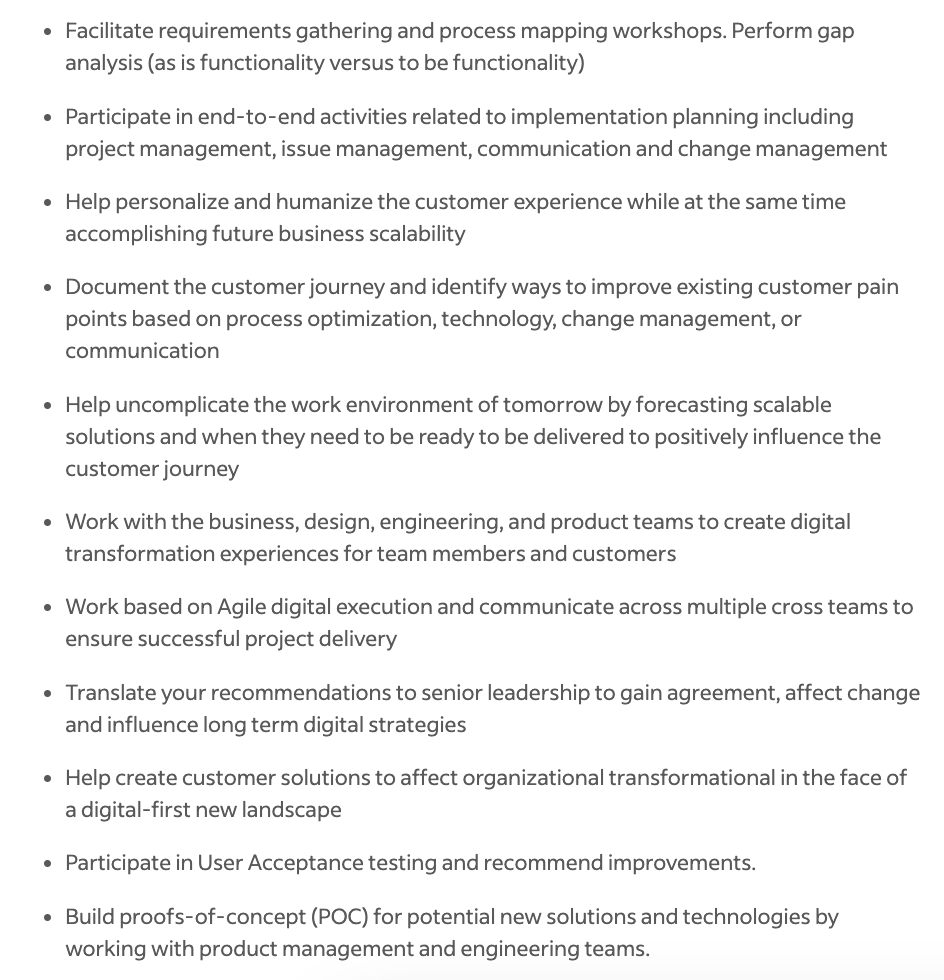
The requirements are simple. Based on the information shared, it seems like the technical product owner will be working as both a functional and technical product owner. However, it is explicitly mentioned that the technical product owner must have a technical background.
Here is another example where it is explicitly stated that the technical product owner will be working with the product owner.
Here is another example where the technical product owner role is merged with a business analyst:
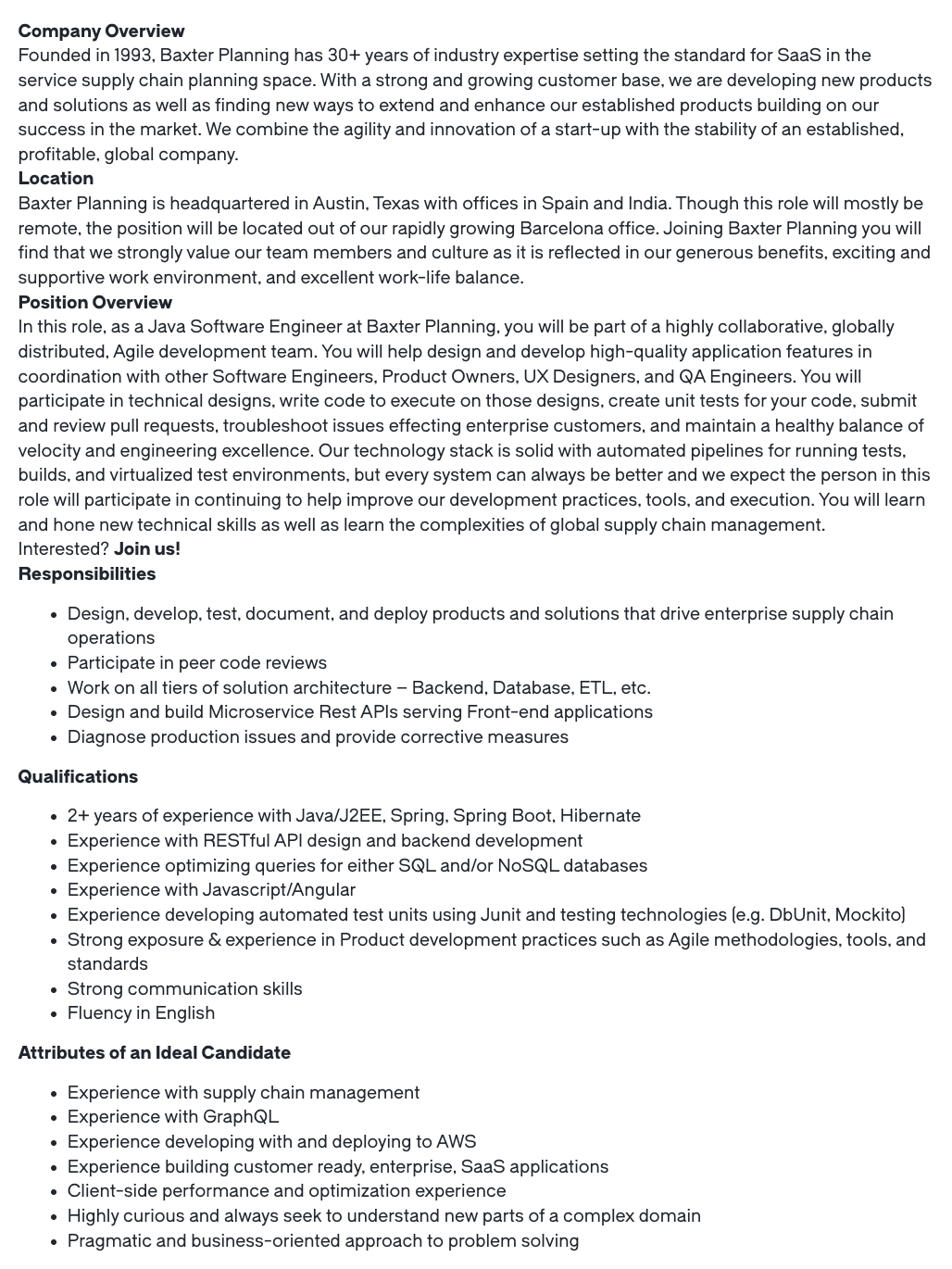
These examples show how the roles and responsibilities vary from organization to organization and project to project. Not all Scrum teams have a technical product owner and the role is entirely need-based so the responsibilities are quite variable.
In all cases, the technical product owner has a purely technical role and is always responsible for doing something that the existing product owner can’t do.
The need for technical assistance emerges when the product owner is having some difficulty in maximizing product value and managing the product backlog efficiently. If things keep working normally, the team doesn’t need a technical product owner.
Technical Product Owner Vs. Product Owner
The difference between a technical product owner and a product owner is minimal and the line is very thin. The scrum team doesn’t have a technical product owner role.
Ideally and in most cases, the product owner is the technical product owner responsible for maximizing product value, including technical and non-technical aspects.
The terms, therefore, are used interchangeably.
A technical assistant product owner role is created for large technical projects that work with the product owner. Here is an example taken of a job advertisement from Forcepoint. This advertisement was posted on Indeed:
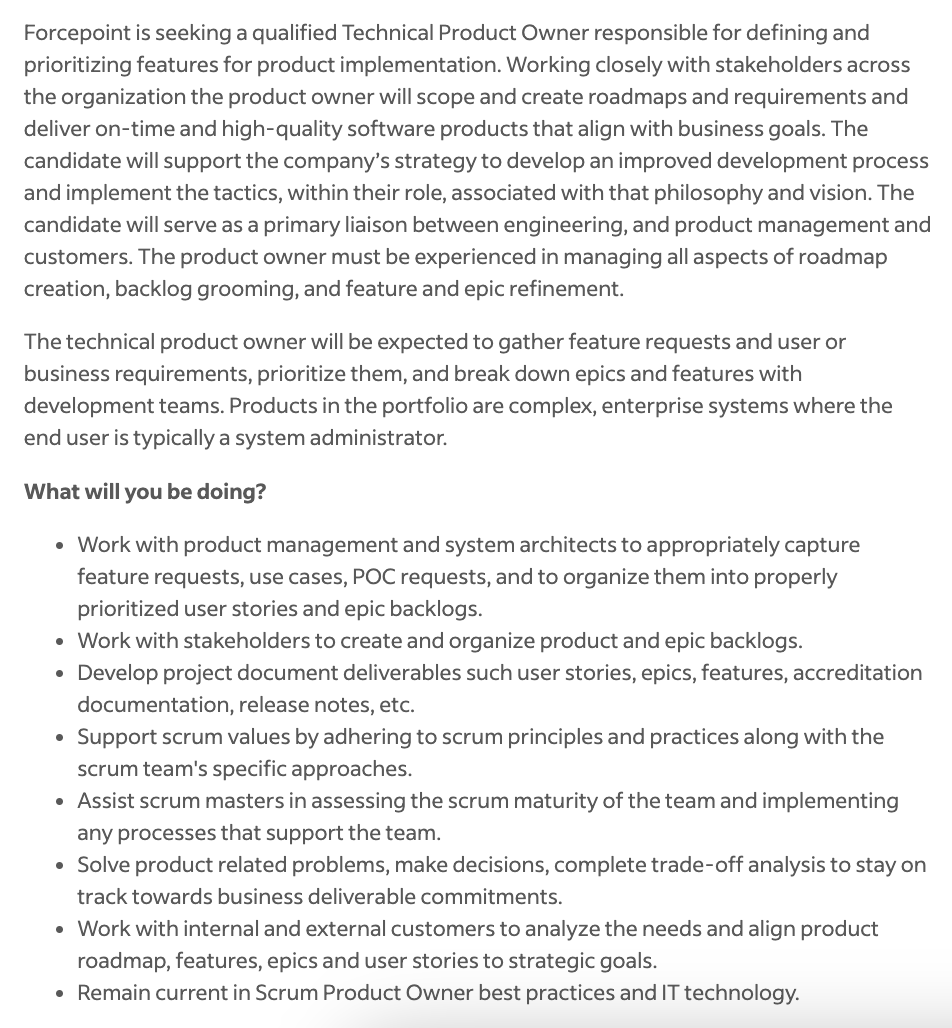
The technical product owner isn’t responsible for managing the backlog and maximizing product value. Rather, their job is to assist the product owner by acting as a technical resource. For example, a technical product owner might be responsible for the long-term software development planning or they might be assigned the task to switch the project to the cloud.
A product owner, on the other hand, is mostly concerned about backlog management. They are more focused on setting product goals, strategy, stakeholder management, and other strategic tasks.
A product owner might not be well-equipped with one or more critical technical decisions or aspects of the development process and that’s where a technical product owner is needed.
In most projects, the product owner is the technical product owner. Both the roles merge and there isn’t any need for a technical resource. Large companies that have complex processes and products often create a technical product owner role.
Final Remarks
A technical product owner plays a vital role in bridging the gap between technical teams and business stakeholders. With a strong technical background, they effectively translate complex requirements into actionable tasks, facilitate smooth communication among teams, and drive the successful delivery of high-quality products. They ensure that the product backlog is well-defined and prioritized, aligning development efforts with business goals and customer needs.
FAQs
Here are answers to the questions that aspiring technical product owners frequently ask:
What is the difference between a product owner and a technical product owner?
A product owner focuses on defining and prioritizing the product backlog to maximize value from a business perspective. A technical product owner, while also managing the backlog, emphasizes the technical capabilities, requirements, and solutions, ensuring alignment with the development team’s capabilities and technical constraints.
What is technical product owner skill?
An expert technical product owner holds strong technical knowledge, soft skills, excellent communication skills, and a solid understanding of Agile methodologies. They bridge the gap between business requirements and technical implementation, ensuring feasibility and alignment with the product vision. They also require an understanding of product roadmap and excellent project management skills.
What is a technical owner?
A technical owner is responsible for overseeing the technical aspects of a product or system, ensuring that technical elements of its development, maintenance, and performance meet specified requirements. They coordinate with development teams to implement technical solutions and address technical challenges.
What is the career path of a technical product owner?
The career path of a technical product owner starts with roles in software development or engineering, progressing to positions such as technical lead or product manager. With experience, they can advance to senior product management roles or executive positions like Chief Technology Officer (CTO) or Chief Product Officer (CPO).
What are technical product owner qualifications?
Technical Product Owner qualifications include:
- Educational Background: A bachelor’s degree in computer science, engineering, or a related field.
- Technical Expertise: Strong knowledge of software development, architecture, and Agile methodologies.
- Experience: Prior experience in product management, software development, or as a technical lead, with a proven track record of managing product lifecycles and collaborating with cross-functional teams.
If you are new to product management and are looking to break into your very first product manager role, we recommend taking our Product Manager Certification Courses, where you will learn the fundamentals of product management, launch your product, and get on the fast track toward landing your first product job.
